What Do I Mean When I Say Celt or Celtic?
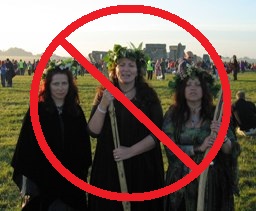
Now, for clarification, I’m not talking about that hokey, new age melting pot of wishful thinking that gets associated with the Celts. I’m talking about a very distinct group of Europeans distinguished by common language and artwork (arguably, as more research is coming out, genetics as well).
When I use the words Celt or Celtic, I use them in the same way we use the terms German or Germanic to refer to groups like the Angles, Saxons, Jutes, Teutons, Goths, Vandals, and the like. They didn’t refer to themselves as German or Germanic, but we can recognize lingual/cultural similarities that tie them all together into a larger group.
Likewise – when I refer to Celts I’m talking about the Celtic Nations (Ireland, Scotland, Wales, Cornwall, The Isle of Man, and Brittany), as well as the areas referred to as Celtic (from the Hallstatt to La Tene Cultures). All of these areas are culturally connected in some way, shape, or form so as to be recognized as Celtic or having been Celtic at some point in history. Also included in this definition are people from the ‘Celticized’ zones represented on the map, as they all at some point are tied archaeologically to Celtic culture.

According to Barry Cunliffe‘s most recent material on the Celts, we can see they are a group who started both linguistically, and genetically, in the Atlantic zone of Europe. They then spread that culture throughout the majority of Europe.
What Do I Mean When I Say Metalhead or Metal Culture?
I’m referring to a very specific group of people when I speak of metal culture. It’s a group that has developed since the first metal bands of the 70’s started amassing a following. This following began to distinguish itself from greater “rock and roll” culture through the following decade, and became a distinctive and separate group in the late 70’s to early 80’s.

In the decades that followed the culture has grown, fractured, and diversified into a large bricolage culture of smaller scenes and sects of metalheads. Many of these groups have their own identities, but are still recognizable as part of the greater umbrella culture.
Introduction:
I’ve been looking for an excuse to compare and contrast these cultures (Metalheads and Celts) for a while now. With the exception of metal music and culture, by far my favorite topic is anything Celtic.
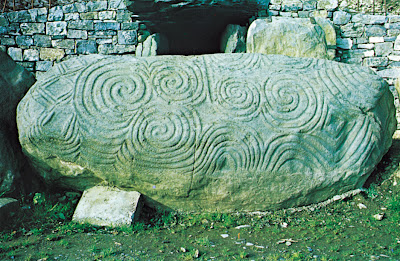 So fucking cool
So fucking cool
On to the Comparisons:
Cultural Composition:

The Celts weren’t a centralized group, they were a bricolage of cultures (similar yet distinct) that were all linked by certain cultural characteristics (art and language).
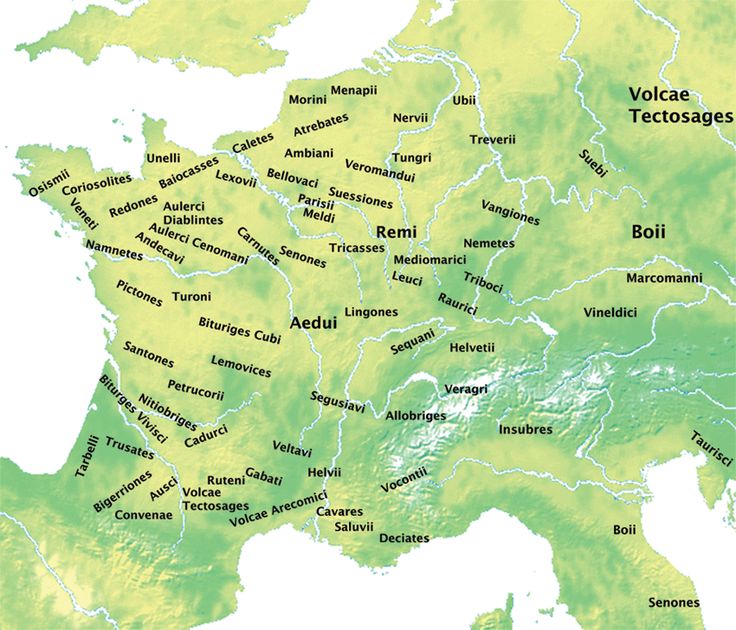

Likewise, there isn’t a centralized heavy metal culture. They’re all branches of the same heavy metal family tree, but each branch is distinct and unique.

(I take no credit for these photographs – the mapping of the metal family tree is the brainchild of Sam Dunn and company at Banger)
So, compositionally speaking Celtic culture is analogous to Metal culture. Both are overarching terms used to identify multiple sub-groups that make up a larger culture.
Art as a Distinguishing Cultural Feature:
Celtic art is one of the most distinguishing facets of the culture. Generally, people who speak of Celtic art are referring to visual styles deriving from what is referred to as “La Tène” art. It’s a distinctive and absolutely beautiful style (all of my tattoos derive from the La Tène style – I guess you could say I’m a bit biased!).
I could get into my argument as to why it shouldn’t be called La Tène (as there’s no proof the artistic style developed in that region – it’s just the first area where this sort of artwork was found, and has led to some very shoddy theories as to the origin of the Celts that hold very little weight with me), but It’d probably take up the rest of the article. Anyways – here’s a few of my favorite examples of artwork we can call Celtic.
Celtic cultures also have very unique music – Irish music is a testament to this. But generally speaking, you can tell Celts at least lived in an area based on the fact that bagpipes are currently (or ever were) played in the area. This even extends to Scandinavian countries, which certainly had contact with Celtic cultures throughout history.
And it’s safe to say that Heavy Metal Culture isn’t just known for a distinctive type of music – the entire culture is based around a distinctive musical style.
Masculinism:
The Celts were almost certainly a masculinist society. I don’t care how many post-menopausal women (who may or may not have “developed/discovered” psychic powers shortly after a bitter divorce/mid-life crisis) tell you otherwise.
This isn’t to say that the Celts didn’t celebrate the feminine as well – they certainly did. But as someone who’s put a fair amount of study into Celtic folklore and literature – I can tell you (the reader) with some certainty that the overriding themes of the culture were masculine in nature.
Likewise, as I have illustrated in another article, heavy metal is also a masculinist culture.
Examples of celebrations of masculinity within each culture can be found in social norms – one of my favorites is facial hair. Both the Celts and Metalheads are pretty famous for long and rather wild facial hair.
While the continental Celts were noted as primarily sporting a mustache (especially nobility), island Celts such as the Irish, Scottish, and Welsh were noted for the growth of a full beard. In fact, it was often seen as dishonorable for a Gaelic man to have no facial hair.
A good example of this can be found in the Welsh legend of Yr Gywddfa, where the warrior Rhita Gawr shaved the beards of two lords as a punishment for arguing(and stitched them together into a cap, before turning them into oxen who could only work when hitched together).
The news of this quickly spread to the kings of the universe, who took it very seriously, “If we permit Rhita Gowr to do this thing, which is the greatest insult against a warrior that can be made, what beard among us will be safe?” They proceeded to (unsuccessfully) wage war against Gawr, who cut off all their beards in turn and fashioned them into a cloak.
Long story short, Rhita Gawr then went for the beard of a warlord named Arthur (who would later be romanticized into the Pendragon of Arthurian legend). Big mistake. Arthur bested him, and as punishment shaved the beard of Gawr and stitched it onto the final empty spot on the beard cloak.
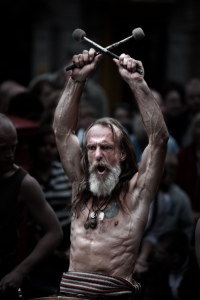
I took enough analytical literature courses (included analyzing literature of oral cultures) where I think it’s safe to infer that the beard was kind of a big deal to the island Celts.
While metal culture is a bit more forgiving when it comes to a lack of facial hair, for the most part you can expect to see anything from goatees to a full-on Viking (or Celt, haha) beards when you go to a metal show/festival. In fact, apart from a black band shirt I’d say facial hair is the most common thing you’ll see on a metalhead.
Also, violent/warlike tendencies. This one’s a little less obvious, but when you see it I think you’ll agree.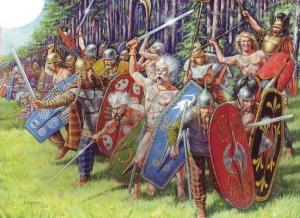
All of the classical writers, when speaking of Celts, at some point mentioned warlike tendencies. The geographer Strabo, who died 24 AD, described the tribes in the interior of
Britain as taller than the Gaulish colonists on the coast and describes the men as warlike, passionate, disputatious, easily provoked, but generous and unsuspicious.
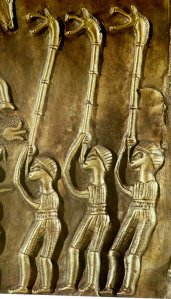
They were also noted for the use of psychological warfare – before a battle, warriors would shout, beat weapons against shields, and employed carnyx players. The sounds had been described as making the earth shake, and was noted as demoralizing the opposing army to a large degree. You might even say they helped pioneer the “wall of sound” so many bands strive to achieve.
Compare that description with these videos:
There are differing opinions on the subject as to why people enjoy moshing, my personal opinion is that it gives the same sensory overload as a war scenario in a (mildly) controlled environment.
My opinion is supported in (and partially derived from) Heavy Metal literature. An example of this can be found in the book “Metalheads: Heavy Metal Music and Adolescent Alienation” by Jeffrey Jenson Arnett. The title of the first chapter of this book is ‘A Heavy Metal Concert: The Sensory Equivalent of War’.
Also interesting to note, the Celts (at least in Ireland) had some rules when it came to war, first and foremost was the notion of fairness (this, like the value placed on facial hair, is a common theme in Celtic mythology). Likewise, anyone who’s been around a few pits will tell you there are certain rules of engagement people tend to follow.
Dress and Appearance:
While the plaid of a tartan bears little resemblance to the obligatory black band shirt that serves as a vital part of the metalhead ‘uniform’ – they both serve the same purpose. They serve as a visual representation of membership to that particular culture. The differences here are obvious – a person is born into a clan with no say in the matter, while membership in metal culture is purely based on personal choice. Regardless, the similarity is worth noting.
Also worth noting is the practice and prevalence of tattooing in both Celtic and Metal cultures.While there is some disagreement as to the prevalence of tattooing among the Celts (many people believe groups like the Picts simply painted themselves, as the very name Pict means “Painted People”), there is absolutely zero question as to the fact that tattooing was practiced among the Celts as far back as 1,000 BC.
And there is no question as to the prevalence of tattoos in Metal Culture.
Fondness for Alcohol
Classical writers like Diodorus, Polybius, and Plutarch all remarked in their writing a certain Celtic fondness for drinking alcohol. The barbaric way in which they consumed it was also noted – they drank wine right out of the bottle (as opposed to the Roman tradition of mixing it with water).
Quantity was as important as quality, and this can be seen from the discovery made at the Vix burial site in France. The most remarkable find in the site (and there were quite a few, it is speculated that the occupant was a princess of some sort) is a wine vessel made of bronze that holds roughly 300 gallons. 300 fucking gallons of wine. Herodotus actually wrote about it, and the writing was considered exaggeration until the find was made.
I’m not just impressed that the continental Celts commissioned the Greeks to make a 300 gallon wine vessel in roughly 500 B.C. That’s cool, but the ridiculous aspect of the whole thing is that it would have been transported FULL OF WINE (that’s a gigantic metal vessel with 300 gallons of liquid) over the fucking Alps to France. Stop and think about that for a second. Look at the size of that thing – people would have trouble doing that with forklifts in modern times. That’s a pretty incredible reverence for alcohol.
On the metalhead side of things, Deena Weinstein dedicates roughly 6 pages (at least in the paperback edition) of her book ‘Heavy Metal’ to Metal Culture’s preoccupation with intoxication – predominantly alcohol. On page 132 she notes that, “Metalheads substances of choice are beer and pot, the former taken over from the bikers and the latter borrowed from the hippies…Drugs and alcohol are commodities to be bought and consumed, but they are also symbolic objects, the meanings of which are integrated into the rest of the subculture.”
Arnett’s book ‘Metal Heads’ makes reference in at least 4 instances to alcohol use in his case studies of young metalheads, and alcoholism in 4 separate instances.
I’m sure there are more literary references to alcohol use and it’s importance in the Metal subculture, but I’m focusing on these two books as they focus on metal culture as a whole (and as such are a tad more relevant to the topic at hand).
And in my own experience – I think it is worth noting that in the 20 plus years I’ve been going to metal shows there has never been a single one where alcohol wasn’t consumed (often to excess) by concertgoers.
Preoccupation with Death Imagery
This is where things get interesting. Heavy Metal, especially the extreme metal branches, is almost synonymous with death imagery. Skulls, Skeletons, Grim Reapers, Corpse Paint, etc. Dark religious themes pervade album covers and song lyrics, and the subject matter of songs themselves quite often pertain to death and the darker aspects of life.
Given the fact that most of my readers are probably metalheads, I’m going to assume this isn’t some sort of life altering revelation.
But the Celts were also obsessed with death imagery, and expressed it in their art and decoration, as well as in mythology. One of my favorites is the “Celtic Beast” from France:
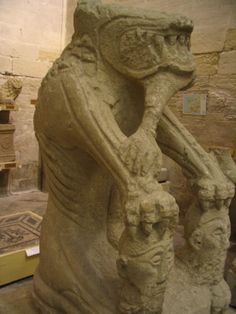
(The Beast of Novace statue from territory associated with the Cavares tribe, 3/2 century B.C.)
You can clearly make out the fact that the monster is holding two severed heads with a severed arm grasped in it’s mouth. Pretty morbid. I’m no scholar, but I’d lump this in the ‘death imagery’ category.
Then you’ve got the Cult of the (Severed) Head. There’s little to no doubt that the Celts were headhunters – it was believed to be the repository of the soul, and is speculated that a Celtic warrior believe keeping the severed head not only prevented his enemy from entering the afterlife, it added the slain man’s power to the victor. There are some scholars who doubt the validity of such a cult, but I think the findings at Roquepertus leave little doubt…
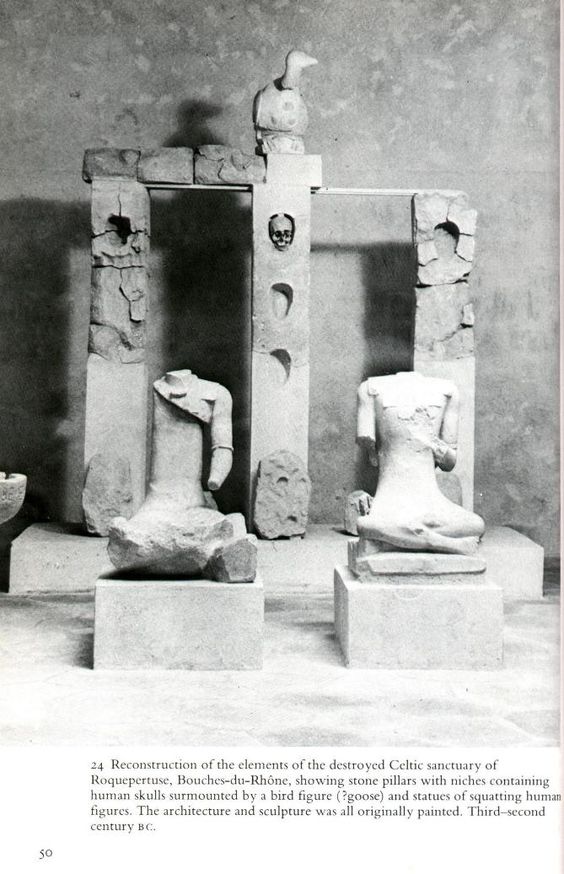
This isn’t some bone Cathedral where people were making use of human remains to make space for more of them. This is a site where figures sitting in poses normally reserved for Celtic gods sit in front of large pillars where severed heads were placedadorned with skull niches. A lot of people speculate that the bird on top of the pillars is a goose – I have a little trouble believing it’s anything other than a vulture (there is a species of Vulture native to Southern France, so it’s not that much of a stretch to assume a carrion bird sits atop a death shrine).
As far as mythology goes – there’s the Dearg Due (literally translates to ‘red blood sucker’ from Gaelic), who was arguably as much of an inspiration for Dracula as Vlad the Impaler (considering Braham Stoker was an Irishman, and his most famous horror character has more in common with and Irish Celtic demon than the supposed basis of the character). It’s been said that locals in county Waterford still pile stones on her grave every year on the eve of her death to prevent her from rising again.
Or, we have the Dullahan (‘Dark Man’ in Gaelic) – the Irish version of the headless horseman. A headless rider on a black horse that roams the countryside as a portent of death. He throws buckets of blood on passerby’s, whenever he calls out a person’s name they die immediately. He uses a human spine as a whip, the wheels of his carriage are made of human thigh bones, and the carriage is covered in human flesh. Interesting side note, a Dullahan is scared of gold – odd considering usually iron is the metal of choice to fend off otherworldly specters in Celtic mythology.
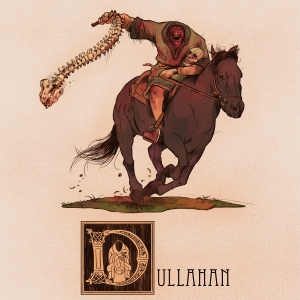
False Accusations of Ritual Sacrifice
Anyone familiar with the Satanic Panic of the 80’s and early 90’s should know what I’m talking about here. Basically, there was this mass endemic of fear in the United States that there was a gigantic Satanic conspiracy threatening the American way of life. One of the chief scapegoats of this was metal culture – I’ve touched on this subject in other articles. A good example of this coming to a head is the case of the West Memphis Three. They were three teenage metal fans who were accused of brutally and sadistically murdering a young child in their hometown – despite a lack of any credible evidence. In fact, plenty of evidence was overlooked to make the case stick.
Likewise, Greek and Roman writers liked to throw the stigma of ritual sacrifice onto the Celts. The most famous accusation (made by both Caesar and Strabo) was that a large group of humans and animals were gathered into a “wicker man” and then burned alive as a sacrifice.
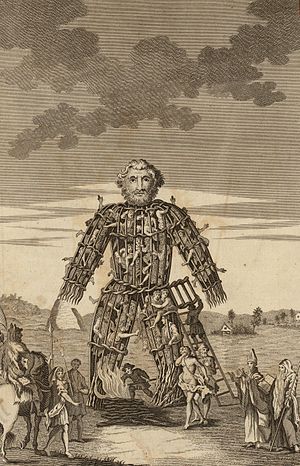
Now, one thing I can’t stand is people who pick and choose what to believe and not to believe in terms of classical writings regarding the Celts. And it may look like that’s what I’m doing, but there’s a method to my madness here. Anything written by classical authors that is confirmed by solid archaeological evidence is safe to consider fact. But it’s also good to take what those Greeks and Romans said with a grain of salt – as they were describing an enemy. And demonizing an enemy in the public eye is always a good idea when you’re waging war against them – as the Romans were known to do from time to time.
So, if there was any evidence of mass graves of humans and animals that were obviously burned – this might be believable. But if there is only a written account and no physical evidence to back it up – I consider it akin to putting someone on trial and finding them guilty with no evidence other than hearsay.
There is evidence of humans being killed in a ritualistic manner – but this does not in and of itself point to human sacrifice. The example generally used is the Lindow Man, an Irish mummy found in a peat bog. Forensics showed that he died a pretty violent death – he was bludgeoned, garroted, and then his throat was slit before he was dumped in the bog. Could it have been a human sacrifice? Sure, it could have. I find it just as likely that this was a form of corporal punishment/the death penalty. And unless some record of it comes to light, we’ll probably never know.
Being an American, I do like to stick to that “innocent until proven guilty beyond a reasonable doubt” thing we like to pretend is the law of the land.
Conclusion:
So there you have it. I’m pretty sure this is all of the similarities I’ve found between the two cultures (besides the fact that both Heavy Metal and Celtic cultures seem to have formed in the general vicinity of the British Isles).
The comparisons between cultures are neat – but it’s good to remember that all human cultures have a tendency to follow certain patterns. As such, I’m sure a similar article could be written comparing Metalheads to Vikings or Saxons or any number of other cultures – but it wouldn’t be anywhere near as fucking cool as this article.
Obligatory Celtic Metal Gallery
Celtic Metal is either hit or miss, here’s a few bands I enjoy.
Happy St. Patrick’s Day from Metal Stuff!
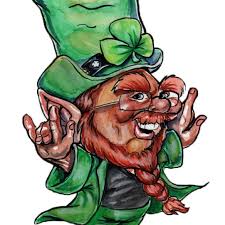

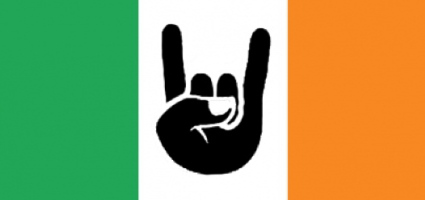


























July 22, 2017 at 5:31 am
I am quite surprised to see it mentioned that Celtic civilization began in the Atlantic, and moved towards the inland areas of Germany. Most scholars I come across, and general information, say it began in La Tene in Switzerland and Halstatt in Austria. Mallory for some reason things Halstatt was in France, but he is the only place I have come across that information.
Going to have to look more into this, but genuinely confused why this Cunliffe guy would say otherwise.
Look forward to reading the rest of the article, when I’m less drunk/tired.
LikeLike
July 23, 2017 at 5:33 pm
Honestly, even Cunliffe has penned books stating the Hallstat origin – this is something that’s come to light in the past 4 years. I think I posted a link to his speech where he lays out the backbone of his theory (using genetics, linguistics, archaeology, etc) to lay out his argument that the “current” view of the Celts is based on speculative research from the 1700’s. It’s never been questioned until now, which he notes is very unscientific.
LikeLike